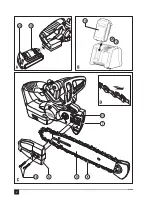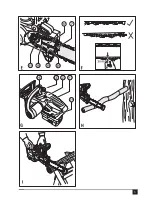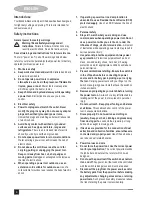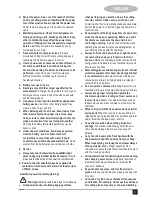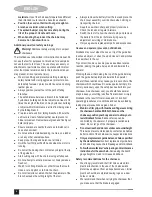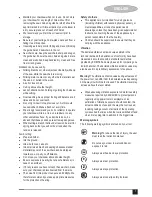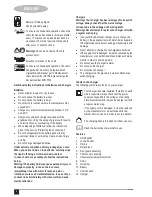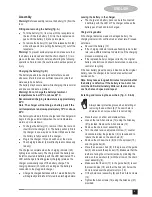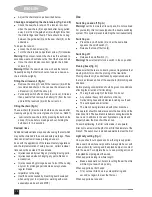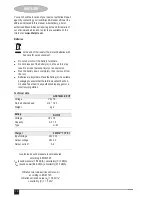
10
ENGLISH
Adjust the chain tension as described below.
Checking and adjusting the chain tension (fig. C and E)
Check the saw chain tension. The tension is correct
when the saw chain (8) snaps back after being pulled
away 3 mm from the guide bar (9) with light force from
the middle finger and thumb. There should be no ‘sag’
between the guide bar (9) and the saw chain (8) on the
underside.
To adjust the tension:
Loosen the 2 Allen screws (14).
Turn the chain tension adjustment screw (7) clockwise.
Warning! Do not over-tension the chain as this will lead to
excessive wear and will reduce the life of the bar and chain.
Once the chain tension is correct, tighten the 2 Allen
screws (14).
Warning! When the saw chain is new, check the tension
frequently during the first two hours of use as a new saw
chain stretches slightly.
Filling the oil reservoir (fig. G)
Remove the oil cap (3) and fill the reservoir (4) with the
recommended chain oil. You can see the oil level in the
oil reservoir (4). Refit the oil cap (3).
Periodically switch off and check the oil level; if it is less
than a quarter full, remove the battery (10) from the tool
and refill the reservoir (4) with the correct oil.
Oiling the chain (fig. G)
The saw chain (8) must be oiled before each use and after
cleaning using only the correct grade of oil (cat. no. A6027).
Lubricate the saw chain (8) by pressing the bulb on the
oil cap (3) twice before making each cut, holding the
bulb down for 3-4 seconds.
Residual risks
Additional residual risks may arise when using the tool which
may not be included in the enclosed safety warnings. These
risks can arise from misuse, prolonged use etc.
Even with the application of the relevant safety regulations
and the implementation of safety devices, certain residual
risks cannot be avoided. These include:
Injuries caused by touching any rotating/moving parts.
Injuries caused when changing any parts, blades or
accessories.
Injuries caused by prolonged use of a tool. When using
any tool for prolonged periods make sure you take
regular breaks.
Impairment of hearing.
Health hazards caused by breathing dust developed
when using your tool (example:- working with wood,
especially oak, beech and MDF).
Use
Switching on and off (fig. G)
Warning! Let the tool work at its own pace, Do not overload.
For your safety, this tool is equipped with a double switching
system. This system prevents starting the tool inadvertently.
Switching on
Press the lock-off button (2) and at the same time
squeeze the on/off switch (1).
Release the lock-off button (2).
Switching off
Release the on/off switch (1).
Warning! Never attempt to lock a switch in the on position.
Pruning trees (fig. H)
Make sure that there are no local by-laws or regulations that
would prohibit or control the pruning of the tree limbs.
Pruning should only be undertaken by experienced users
there is an increased risk of the saw chain (8) pinching and
kickback.
Before pruning consideration should be given to conditions
affecting the direction of fall including:
The length and weight of the branch to be cut.
Any unusual heavy limb structure or decay.
Surrounding trees and obstacles including overhead.
The wind speed and direction.
The branch being intertwined with other branches.
The operator should consider access to the tree limb and the
direction of fall. The tree branch is liable to swing towards the
tree trunk. In addition to the user bystanders, objects and
property below the branch will be at risk.
To avoid splintering, the first cut is made in an upward
direction to a maximum depth of one third the diameter of the
branch. The second cut is made downwards to meet the first.
Light duty cutting (fig. I)
How you should cut depends on how the log is supported.
Use a saw horse whenever possible. Always start a cut with
the saw chain (8) running and the spiked bumper in contact
with the wood. To complete the cut, use a pivoting action of
the spiked bumper against the wood.
When supported along its whole length:
Make a downward cut, but avoid cutting the earth as this
will blunt your saw chain quickly.
When supported at both ends:
First, cut one third down to avoid splintering and
second, cut again to meet the first cut,
When supported at one end:
Summary of Contents for GKC1820L-XE
Page 1: ...Australia New Zealand GKC1820L XE www blackanddecker com au 12 ...
Page 2: ...2 12 23 10 ...
Page 3: ...3 ...
Page 13: ...13 GKC1820L XE ...
Page 14: ...14 ...
Page 15: ...15 ...


